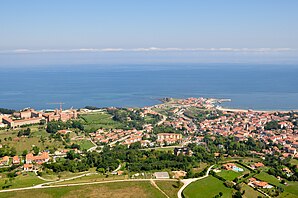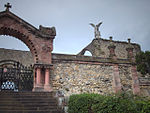Comillas
| Comillas municipality | ||
|---|---|---|
 View of Comillas
|
||
| coat of arms | Map of Spain | |

|
|
|
| Basic data | ||
| Autonomous Community : |
|
|
| Comarca : | Costa occidental | |
| Coordinates | 43 ° 23 ′ N , 4 ° 17 ′ W | |
| Height : | 23 msnm | |
| Area : | 18.6 km² | |
| Residents : | 2,141 (Jan 1, 2019) | |
| Population density : | 115.11 inhabitants / km² | |
| Municipality number ( INE ): | 39024 | |
| administration | ||
| Mayor : | Maria Teresa Noceda Llano | |
| Website : | www.aytocomillas.es | |
Comillas is a municipality in the Autonomous Community of Cantabria in northern Spain . It is located around 40 km west of Santander . In addition to the capital, the villages of La Rabia, Rioturbio, Rubárcena, Ruiseñada and Trasvía belong to the municipality.
history
The place is traditionally known as the "City of Archbishops". For a long time, fishing and agriculture were important, but recently the primary sector has been replaced by the tertiary sector, i.e. tourism and service industries. King Alfonso XII and many nobles from Madrid , Barcelona , Seville and Bilbao preferred to spend part of their time in places like Comillas.
The municipality was the first settlement in Spain with electrically operated street lighting . Its establishment was promoted by the family of the Marques de Comillas, especially the 2nd Marques Claudio López Bru .
Population development
| year | 1991 | 1996 | 2001 | 2004 | 2006 |
|---|---|---|---|---|---|
| Residents | 2,495 | 2,364 | 2,289 | 2,469 | 2,467 |
Attractions
El Capricho (the whim ) by Antoni Gaudí
Comillas is rich in architecture of late historicism and early modernism , mainly due to the patronage of Claudio López Bru .
Some of the most outstanding examples:
- Palacio de Sobrellano (built 1878–1890 by Joan Martorell for the Márques de Comillas)
- Panteón de Sobranello (chapel right next to the Palacio de Sobranello, also built by Martorell in 1881, the interior was designed by the young Antoni Gaudí )
- Building of the Pontifical University of Comillas (Spanish: Universidad Pontificia Comillas ), started in 1883 by Martorell, completed by Lluís Domènech i Montaner ; The university was founded by Claudio López Bru in Comillas, the main campus is now in Madrid.
- Villa Quijano , also known as "El Capricho" (built 1883–1885 by Antoni Gaudí as a summer country house for a wealthy businessman. The building's design with a multitude of sunflower patterns and the minaret- like entrance towerare striking.
- The cemetery (built by Lluís Domènech i Montaner in the ruins of a church)
The entrance to the La Meaza cave is in the municipality's territory . It is owned by the Government of Cantabria. In 1907 the cave was intensively explored. It contains traces of paleolithic burial rites and other references to the settlement of the area by cultures of the European late Paleolithic such as Azilien and Solutréen .
Personalities
- The initiative of the entrepreneur Antonio Lopez y Lopez brought the place to the peak of its economic and social prosperity at the turn of the 19th and 20th centuries. Antonios friendship with the Spanish crown as well as his financial influence helped him in 1882 to the title of 1st Marques de Comillas, which was given to him by King Alfonso XII. was awarded.
- The Catholic clergyman Antonio de Hornedo Correa , who spent much of his life in Peru , was born in Comillas in 1915.
Twin town
Web links
- photos
- Attractions (spanish)
Individual evidence
- ↑ Cifras oficiales de población resultantes de la revisión del Padrón municipal a 1 de enero . Population statistics from the Instituto Nacional de Estadística (population update).
- ↑ Comillas | Country & People | Surf vacation. Retrieved on September 23, 2019 (German).





